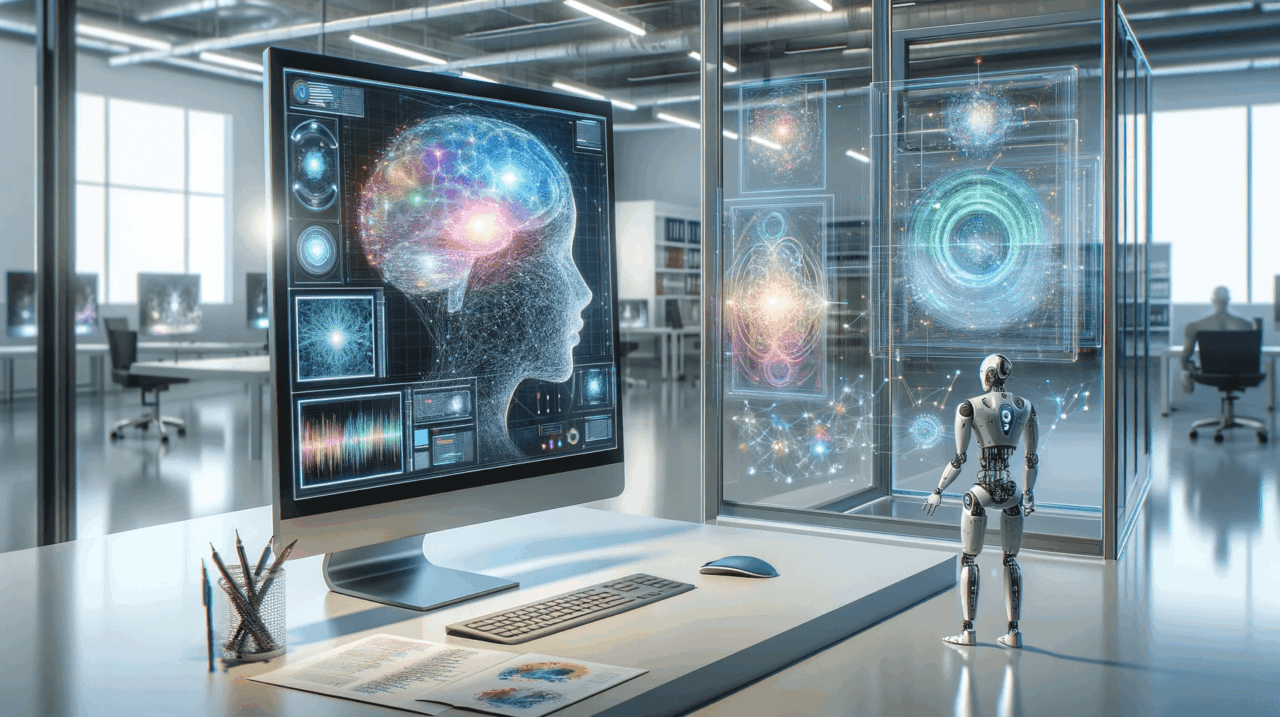Introduction to AI Generative Models

Introduction
Generative AI (Gen AI) represents a groundbreaking shift in the landscape of artificial intelligence. Unlike traditional AI models that primarily focus on data analysis and prediction, Gen AI takes a creative leap forward. It’s not just about understanding or processing information; it’s about creating it. This creation spans across a spectrum of digital media – from textual content to complex images and even music. The essence of Gen AI lies in its ability to learn from existing data and generate new, original content that mimics or extends the patterns it has discerned.
The core concept behind this technology is the learning of data patterns and structures. These AI models absorb the intricacies of their training data, developing an understanding of underlying probability distributions. This understanding enables them to produce new data samples that not only resemble the original training data but also maintain a semblance of novelty and innovation.
Recent advancements have seen Gen AI transitioning from a niche, tech-centric topic to a matter of strategic importance at the highest levels of business. With companies increasingly integrating Gen AI into various business functions, its role has evolved from a mere tool for tech teams to a key component of organizational strategy and innovation.
The rapid ascent of Gen AI is underscored by its widespread adoption across diverse industries and regions. It’s being leveraged for work and creative endeavors globally, with significant impacts anticipated in knowledge-intensive sectors such as technology, finance, healthcare, and education. This widespread usage underscores the versatile nature of Gen AI, capable of adapting to and enhancing a broad range of industry-specific applications.
However, the journey of Gen AI is not without its challenges. High-performing companies, while leading the way in Gen AI adoption, still confront obstacles in realizing its full value. The challenges range from operational aspects, like model performance monitoring and retraining, to strategic considerations such as defining a clear AI vision that aligns with business objectives.
As we delve deeper into this revolutionary AI paradigm, it’s essential to understand not just its capabilities but also the challenges and responsibilities it brings. The rise of Gen AI heralds a new era in technological innovation, one that promises to reshape industries, redefine creativity, and potentially alter the very fabric of our digital lives.
Understanding AI Generative Models
Definition and Overview
Generative AI, a subset of artificial intelligence, is redefining the realms of creativity and computation. These models, driven by complex mathematical algorithms and substantial computing power, are essentially prediction machines trained on vast, unlabeled data. They excel in generating new, realistic artifacts that echo the traits of their training data without mere replication. This capability extends to a diverse array of content including images, videos, music, speech, text, and even intricate product designs.
Foundation models are the backbone of modern generative AI, adapted for a wide range of tasks with additional fine-tuning. These models, like ChatGPT, Midjourney, and MusicLM, respond to textual prompts to generate novel content, embodying the convergence of creativity and AI technology. Their applications range from generating essays and illustrations to composing music, showcasing a vast spectrum of potential that continues to grow and evolve.
Historical Evolution
The journey of generative AI from a concept to a transformative technology reflects a decade of evolution in machine learning techniques. It began with simpler models focused on specific tasks and has now evolved to sophisticated neural network architectures like transformers, capable of handling a variety of complex tasks. This evolution underscores a shift from mere data interpretation to active data creation, marking a significant milestone in AI’s capabilities.
The proliferation of generative AI across various industries is not just about technological advancement; it’s a reflection of its ability to adapt and enhance industry-specific applications. From drug and chip design to material science development, generative AI is paving the way for innovations that were once considered beyond the scope of automated systems.
Types of Generative Models
Different types of generative models, such as Generative Adversarial Networks (GANs), Variational Autoencoders (VAEs), diffusion models, and transformer-based models, each offer unique features and applications. GANs, for instance, have been instrumental in creating photorealistic images, while VAEs are known for their efficiency in data compression and generation. Diffusion models are making strides in image generation and editing, and transformer-based models like GPT-3 have revolutionized natural language processing. The diversity of these models signifies the breadth of generative AI’s capabilities and its potential to cater to a myriad of use cases across industries.
Applications of AI Generative Models
The applications of generative AI are as varied as the models themselves. From enhancing creative processes in art and design to accelerating drug discovery in pharmaceuticals, these models are reshaping industries. In the realm of content creation, they are instrumental in generating realistic images, videos, and texts, often indistinguishable from human-created content. Their impact is also evident in areas like 3D modeling and game development, where they contribute to more efficient and sophisticated designs.
The transformative effect of generative AI extends beyond professional domains. In everyday life, these models have the potential to personalize user experiences, automate routine tasks, and even aid in educational tools, offering customized learning experiences. The versatility of generative AI models lies in their ability to not only mimic human creativity but also to enhance it, opening new avenues for innovation and exploration.
Challenges and Ethical Considerations
With the immense capabilities of generative AI come significant challenges and ethical considerations. One of the primary concerns is the potential for these models to amplify existing biases in the data they are trained on. This can lead to skewed outputs that perpetuate stereotypes or misinformation. Additionally, issues of copyright and intellectual property arise when generative AI models create content that closely resembles existing works. Ensuring that these models respect intellectual property rights and do not inadvertently infringe on copyrighted materials is crucial.
Another concern is the environmental impact of training and operating these models. The computational resources required for generative AI are substantial, leading to significant energy consumption. Addressing the sustainability aspect of generative AI is critical to ensuring its responsible and ethical use.
The challenges of generative AI underscore the importance of continuous monitoring and updating of these models to ensure they remain accurate, unbiased, and aligned with ethical standards. This ongoing process requires a collaborative effort from developers, researchers, and users to identify and address any issues that arise.
How AI Generative Models Work
Training Process
Generative AI models, at their core, are sophisticated learning systems. Their training process involves absorbing vast amounts of data, recognizing patterns and structures within this data, and then using this learned information to generate new, similar content. This process hinges on the concept of learning the underlying probability distributions of the data. For instance, when trained on a dataset of images, these models learn to understand the features and styles of these images and can then generate new images that exhibit similar characteristics.
This learning process is achieved through a variety of methods, each with its unique approach to handling data and generating outputs. The complexity and diversity of these methods reflect the advanced nature of current AI technology and its ability to handle a wide range of tasks. From generative adversarial networks (GANs) that pit two neural networks against each other to create new data, to transformer-based models like GPT-3 that revolutionize natural language processing, each method contributes to the vast capabilities of generative AI.
Types of Generative Models
The landscape of generative AI models is diverse, with each model offering unique capabilities and applications. Some of the prominent types include:
- Generative Adversarial Networks (GANs):
These involve two neural networks, a generator and a discriminator, working in tandem. The generator creates data, and the discriminator evaluates it. Through this process, the generator learns to produce more accurate and realistic data. - Variational Autoencoders (VAEs):
VAEs are effective in compressing data and then generating data similar to their input. They are particularly useful in fields like image and speech processing. - Diffusion Models:
These models are relatively new and are known for their ability to generate high-quality images. They work by slowly adding noise to an image and then learning to reverse this process to create new images. - Transformer-Based Models:
Models like GPT-3 fall under this category. They have revolutionized natural language processing with their ability to understand and generate human-like text.
Each of these models has its strengths and is suited for different types of generative tasks. For example, GANs are often used for creating photorealistic images, while VAEs are more common in scenarios where data compression is crucial.
Challenges in Training and Development
Training generative AI models is not without its challenges. One of the primary hurdles is the requirement of large datasets for training. These datasets must be diverse and comprehensive enough to enable the models to learn a wide range of features and patterns. Additionally, the computational resources needed for training these models are significant, often requiring powerful GPUs and substantial energy.
Another challenge is ensuring the models do not reinforce or amplify biases present in the training data. This requires careful curation of the datasets and continuous monitoring of the models’ outputs.
Lastly, maintaining the balance between innovation and accuracy in the generated content is crucial. The models must be able to generate novel content while still adhering to the patterns and structures learned during training.
Conclusion
In conclusion, the working of AI generative models involves complex training processes and a variety of model types, each with its unique capabilities and challenges. Understanding these aspects is crucial for leveraging the full potential of generative AI in various applications.
Applications of AI Generative Models
Emerging Applications in Various Industries
The current landscape of generative AI (Gen AI) tools exhibits a striking diversity in applications, creating content across modalities such as text, image, video, and audio. These tools are being tailored to meet specific industry and function needs, with a clear trend towards applications that target particular sectors, promising greater value than more general solutions. For example, in marketing, Gen AI is being used for creating personalized emails and posts, while in customer service, it powers chatbots to enhance user interaction on websites. In more technical domains, such as IT, Gen AI aids in automatic code generation and rapid user interface design. In creative fields, it facilitates the generation of unique media and personalized content.
Impact on Specific Sectors
While all industries stand to gain from Gen AI, certain sectors may benefit more significantly. Industries like high tech and banking are poised to see a considerable impact, especially through Gen AI’s potential to expedite software development. This advancement is not just about technological innovation but also about enhancing efficiency in crucial business functions like marketing and sales, where Gen AI can drive lead identification, marketing optimization, and personalized outreach.
Gen AI in Workforce Productivity and Experience
A notable aspect of Gen AI is its role in improving workforce productivity and experience. In software engineering, Gen AI tools have shown impressive gains in speeding up common developer tasks such as code documentation, writing new code, and code refactoring. These tools not only enhance efficiency but also contribute to a more positive work experience for developers. They automate repetitive tasks and provide quick access to information, which in turn can help organizations retain their best talent.
Adoption Trends and Skill Gaps
Despite its potential, the full utilization of Gen AI in commercial activities is still emerging. A significant percentage of marketing and sales leaders believe their organizations should use Gen AI more frequently than they currently do. This gap indicates a burgeoning demand for Gen AI-literate employees, highlighting the need for organizations to develop talent management strategies that cater to this new technology wave.
Caution in Implementation
Organizations are advised to approach Gen AI implementation with caution, considering potential risks such as biased outputs, factual inaccuracies, or copyright issues. Ensuring human oversight in Gen AI applications is crucial to mitigate these risks and uphold reputational and legal standards.
Broader Economic Impact
Looking at the broader picture, Gen AI holds the potential to substantially boost global GDP by increasing labor productivity. However, this requires a shift in the workforce, with workers adapting to new roles and acquiring new skills to match the evolving job landscape shaped by Gen AI.
In conclusion, the applications of Gen AI are vast and varied, with significant implications for various industries, workforce dynamics, and the global economy. As these models continue to evolve and integrate into different sectors, understanding their potential and challenges becomes imperative for leveraging their full capabilities responsibly.
Challenges and Ethical Considerations of AI Generative Models
Ethical Issues and Risks
Generative AI, like other forms of artificial intelligence, raises a number of ethical concerns and risks. These include issues around data privacy, security, and potential impacts on workforces. Moreover, generative AI technologies could generate new business risks, such as misinformation, plagiarism, copyright infringements, and distribution of harmful content. The potential for worker displacement is another critical issue that needs addressing in the deployment of these technologies.
Data Privacy and Sensitive Information Disclosure
A significant concern with generative AI is data privacy violations. Large language models (LLMs) trained on datasets may include personally identifiable information (PII), which can be problematic, especially when compared to traditional search engines. Ensuring that PII isn’t embedded in these models and that it’s easy to remove such information in compliance with privacy laws is crucial. Additionally, the democratization of AI capabilities increases the risk of inadvertently disclosing sensitive information, potentially leading to breaches of trust and legal ramifications.
Amplification of Existing Biases
Another challenge is the amplification of existing biases. Bias in training data can be unintentionally carried over into the outputs of generative AI models. This emphasizes the need for diversity among leaders and experts working on AI to help identify and mitigate unconscious biases in data and models. Ensuring fairness and equity in AI outputs is a major ethical consideration that must be taken into account during the development and deployment of these technologies.
Impact on Workforce and Organizational Change
Generative AI can significantly alter workforce roles and morale. As these technologies take over more daily tasks traditionally done by knowledge workers, such as writing and content creation, concerns about worker displacement and replacement are heightened. Ethically, companies need to invest in preparing their workforce for new roles created by generative AI applications, focusing on skills like prompt engineering. This approach helps in minimizing negative impacts and prepares companies for growth in an AI-integrated future.
Data Provenance and Lack of Explainability
The issue of data provenance is also significant. The vast volumes of data consumed by generative AI systems can sometimes be inadequately governed or of questionable origin. Additionally, the lack of explainability and interpretability in many generative AI systems poses challenges. These systems often lack the ability to provide causal explanations for their outcomes, relying instead on correlations. Ensuring transparency and interpretability in AI models is essential for building trust and understanding the rationale behind AI-generated content and decisions.
In conclusion, while generative AI models offer tremendous potential, their deployment comes with a range of ethical challenges and considerations. Addressing these issues requires a comprehensive approach that includes clearly defined strategies, good governance, and a commitment to responsible AI.
Future of AI Generative Models
Advancements and Broad Impact
Generative AI has undergone significant advancements in recent years, primarily due to the development of large language models (LLMs) like ChatGPT, powered by transformer technology. These advancements have enabled higher-quality generation of text, images, voices, and synthetic data. Generative AI is now being widely recognized for its potential in enhancing business, productivity, and artistic creativity. It is increasingly accessible to a broad audience, thereby integrating AI into everyday life.
General-Purpose Technology
Generative AI is increasingly being viewed as a new general-purpose technology, akin to the steam engine and electricity in terms of its broad impact. Its potential to act as a “second brain” is expected to improve productivity and efficiency across various industries. This technology is freeing up cognitive bandwidth, allowing professionals to focus on higher-impact and value-driven tasks.
Key Future Trends
- Prompt-Based Creation:
This trend is particularly notable in fields like art, music, and natural language processing, where the ability to create content based on prompts is evolving. This will likely necessitate the development of prompt engineering skills to produce more refined content. - APIs for Enterprise Applications:
The development of new APIs is expected to integrate various generative AI capabilities into enterprise applications. This integration can enhance a wide range of applications, from mobile apps to complex enterprise software, influencing productivity and customer relationship management (CRM). - Business Process Reimagination:
As generative AI becomes more sophisticated, it is likely to automate or augment a broad spectrum of everyday tasks, leading to the emergence of new business models and AI-native experiences. This change could allow businesses of all sizes to operate more efficiently and adaptively. - Healthcare Applications:
In healthcare, generative AI has the potential to improve patient outcomes and facilitate healthcare professionals’ work. Uses include the extraction and digitization of medical documents, personalized medicine, and intelligent transcription to aid doctor-patient communication. - Enhanced Synthetic Data:
Generative AI is poised to improve the utility of synthetic data, addressing privacy concerns and regulatory challenges. This improvement could enable rapid development of new AI models and enhance decision-making capabilities. - Effective Scenario Planning:
Generative AI could enhance the ability to simulate and plan for large-scale macroeconomic or geopolitical events, aiding in navigating complex supply chain disruptions and other global challenges. - Hybrid Models for Reliability:
The future of generative AI might involve combining multiple models, such as LLMs with symbolic AI, to enhance accuracy and reliability, especially in regulated industries. - Personalized Applications:
A rise in personalized generative applications is expected, catering to individual user preferences and behavior patterns in various sectors, including education and enterprise workflows. - Domain-Specific Applications:
There will be a growing focus on fine-tuning generative AI for domain-specific applications, enhancing industry-specific workflows and insights. - Natural Language Interfaces (NLIs):
Generative AI is predicted to drive the development of more intuitive and user-friendly NLIs, facilitating more natural communication with computer systems and improving efficiency in various operational contexts, such as supply chain management.
In conclusion, the future of AI generative models holds exciting prospects across various domains, promising significant advancements in how businesses operate and how professionals engage with technology. The continued evolution of these models is set to redefine the landscape of numerous industries, enhancing productivity, creativity, and decision-making processes.
Conclusion
Reflecting on the Generative AI Revolution
The landscape of generative AI (gen AI) has undergone a dramatic transformation, evolving from a niche topic to a focal point for both technology professionals and company leaders. The recent McKinsey Global Survey has highlighted the swift adoption and integration of gen AI tools in various business functions. A notable shift has occurred, with gen AI rising to prominence in the agendas of C-suite executives and board discussions. This trend is indicative of the broader recognition of gen AI’s potential to significantly impact business operations and strategies.
Gen AI’s Influence on Business and Workforce
The impact of gen AI on businesses is expected to be substantial, with profound changes anticipated in workforce dynamics. Organizations are preparing for these shifts, focusing on reskilling efforts to adapt to the evolving talent needs brought about by gen AI advancements. However, it’s crucial to note that while the adoption of gen AI tools is expanding rapidly, this growth has not yet led to a corresponding increase in overall AI adoption across organizations. The use of AI remains concentrated within specific business functions, suggesting that there’s significant untapped potential for AI to transform other areas of business operations.
Emerging Trends and Challenges
High-performing organizations are leading the way in leveraging gen AI for creating new business models and enhancing existing offerings. These companies are focusing on the strategic utilization of gen AI to drive innovation and revenue generation, rather than merely reducing costs. However, they also face challenges, particularly in managing gen AI-related risks and ensuring the effective integration of these technologies into their existing systems and processes. Specialized technologies and practices, such as machine learning operations (MLOps), are crucial for adopting transformative gen AI applications safely and efficiently.
Workforce Transformation
Looking ahead, the role of AI in reshaping the workforce is becoming increasingly evident. A significant proportion of employees are expected to undergo reskilling to align with the changing demands of an AI-driven work environment. This trend underscores the importance of continuous learning and adaptability in the workforce to harness the benefits of gen AI and other AI technologies.
In conclusion, the rise of generative AI marks a pivotal moment in the evolution of artificial intelligence and its integration into various aspects of business and society. As organizations navigate this landscape, they must balance the potential benefits of gen AI with the need to address its challenges and ethical implications, ensuring responsible and effective adoption of these transformative technologies.



 Jun 17,2024
Jun 17,2024  By Julien Gauthier
By Julien Gauthier